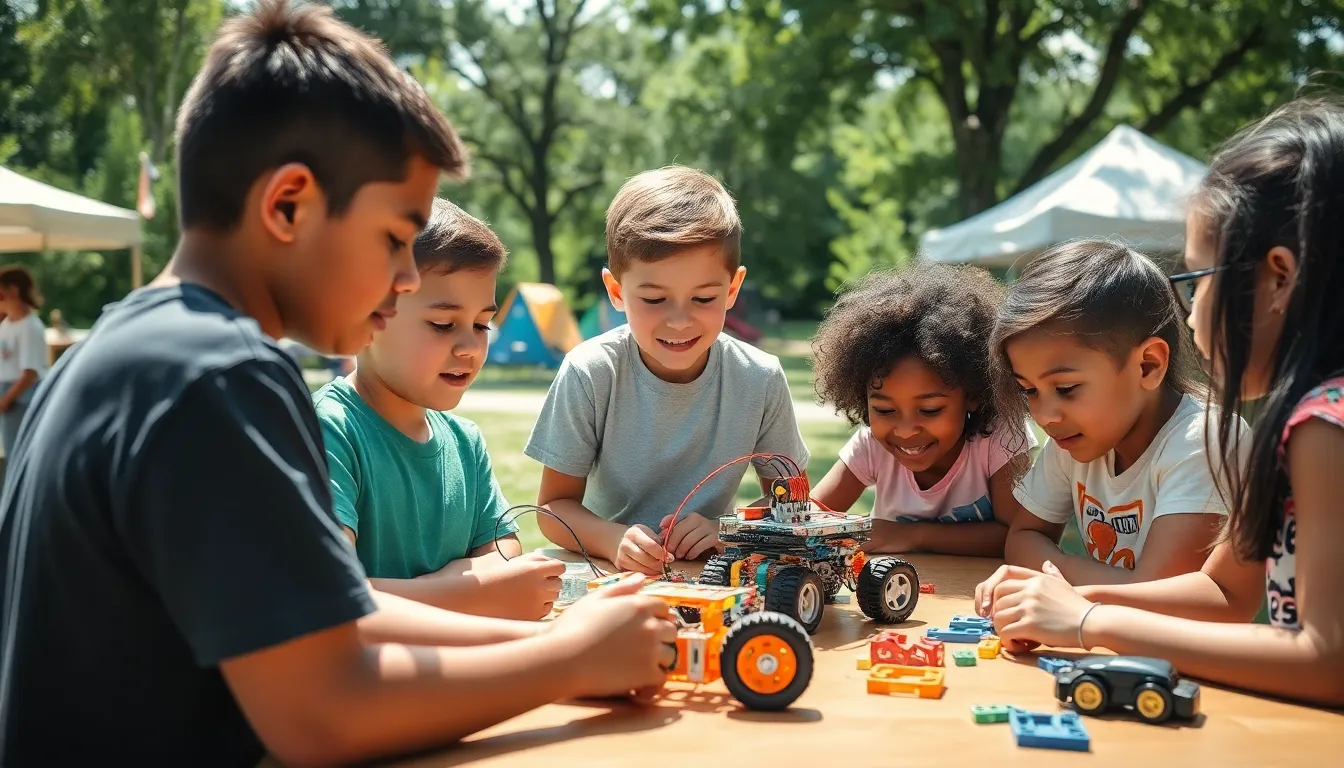As summer approaches, parents often seek engaging and educational activities for their children. Summer STEM camps have emerged as a popular choice, blending fun with learning in science, technology, engineering, and mathematics. These camps provide a unique opportunity for kids to explore their interests and develop essential skills in a hands-on environment.
At summer STEM camps, children dive into exciting projects that spark creativity and critical thinking. From coding and robotics to environmental science and engineering challenges, these programs cater to a wide range of interests. With expert guidance and collaborative activities, participants not only gain knowledge but also build confidence and teamwork skills that will benefit them long after summer ends.
Table of Contents
ToggleOverview of Summer STEM Camps
Summer STEM camps offer children engaging opportunities to explore science, technology, engineering, and mathematics through hands-on learning. These camps cater to various age groups, typically ranging from 5 to 18 years old, ensuring that all participants find suitable challenges and activities.
Activities at summer STEM camps often include:
- Coding: Participants learn programming languages such as Python or Scratch, enabling them to create apps or games.
- Robotics: Campers design and build robots, applying principles of engineering and problem-solving.
- Environmental Science: Kids explore ecology and sustainability, engaging in projects that promote awareness of environmental issues.
- Mathematics Challenges: Innovative games and real-world applications help enhance mathematical skills while maintaining interest.
The benefits of attending summer STEM camps are notable. Children develop critical thinking, creativity, and collaboration skills. Additionally, exposure to STEM fields nurtures an early interest in possible career paths, preparing participants for future academic pursuits.
Each camp typically runs for one to several weeks, providing intensive engagement with skilled instructors. Many summer STEM camps also feature field trips, guest speakers, and competitions that add to the overall experience and enrich learning.
Parents often find these camps an excellent option for summer enrichment, as they balance fun and education effectively. By fostering a love for STEM subjects, summer camps create a foundation for lifelong learning and curiosity.
Benefits of Summer STEM Camps

Summer STEM camps offer various benefits that significantly contribute to children’s development in both academic and social aspects.
Skill Development
Summer STEM camps focus on enhancing essential skills through engaging, hands-on activities. Participants develop critical thinking skills by solving complex problems. They nurture creativity through designing projects like robots or software applications. Collaboration skills improve as campers work in teams on group challenges. Exposure to coding languages like Python and Scratch helps participants build programming proficiency. Camps often include math exercises that promote analytical skills. Instructors guide students, ensuring they gain practical knowledge applicable to future academic endeavors.
Social Interaction
Social interaction forms a vital component of summer STEM camps. Campers collaborate during activities, fostering teamwork and communication skills. They connect with peers who share similar interests, creating friendships that extend beyond the camp environment. Interaction with instructors and guest speakers enhances networking opportunities and mentorship. These experiences teach campers respect for diverse perspectives, vital for future STEM careers. Engaging in group projects encourages problem-solving as a team, preparing participants for real-world collaboration. The supportive camp atmosphere nurtures confidence in social settings, contributing to a well-rounded personal development.
Popular Types of Summer STEM Camps
Summer STEM camps encompass a variety of themes, attracting diverse interests among children. Three popular types include robotics camps, coding camps, and environmental science camps.
Robotics Camps
Robotics camps focus on designing, building, and programming robots. Participants work with materials like motors, sensors, and microcontrollers to create functioning robots that can perform specific tasks. Programs typically introduce concepts like circuits and coding languages essential for robotics. Teams often compete in challenges that require problem-solving and creativity, fostering collaboration and technical skills.
Coding Camps
Coding camps concentrate on teaching children programming skills through game development, app creation, and web design. Participants learn languages such as Python, Scratch, and JavaScript, promoting logical thinking and computational skills. Activities often include creating interactive games or websites, allowing campers to express creativity while building a strong foundation in technology. By the end of the camp, participants commonly showcase their projects, demonstrating their accomplishments.
Environmental Science Camps
Environmental science camps engage campers in hands-on experiences related to ecology, sustainability, and conservation. Participants explore topics like wildlife habitats, renewable energy, and water cycle processes through experiments and fieldwork. Activities may include nature walks, data collection, and creating eco-friendly projects. Campers often work on community service projects that promote environmental awareness, emphasizing the importance of protecting the planet.
Choosing the Right Summer STEM Camp
Selecting an appropriate summer STEM camp involves considering factors like age appropriateness, camp location, and program curriculum. These elements help ensure that children receive a beneficial and enjoyable experience.
Age Appropriateness
Age-appropriate camps cater specifically to various developmental stages. Programs designed for younger children, typically aged 5 to 8, focus on basic concepts through playful learning techniques. Camps for ages 9 to 13 introduce more complex topics like coding and robotics. Teens, aged 14 to 18, often engage in advanced projects that challenge their knowledge and skills, such as artificial intelligence or engineering design. Confirming that a camp aligns with a child’s age ensures an engaging and stimulating environment.
Camp Location
Camp location affects accessibility and logistics for participants. Choosing camps conveniently located, whether in local community centers, universities, or online, simplifies transportation and communication for parents. For families willing to travel, some prestigious camps may offer unique programs in scenic locations, adding an exciting dimension to the experience. Evaluating the distance and safety of the location helps in making an informed decision about a summer STEM camp.
Program Curriculum
Program curriculum defines the focus and depth of experiences offered in each camp. Reviewing curricula ensures alignment with a child’s interests and educational goals, whether focusing on robotics, coding, or environmental science. Effective camps often blend theoretical concepts with hands-on activities, allowing children to apply what they learn. Assess curriculum details, including daily schedules and project outcomes, to gauge whether the camp will meet the child’s learning expectations and lead to skill development.
Summer STEM camps offer a unique blend of education and enjoyment that can significantly impact a child’s growth. By participating in these camps, kids not only explore their interests but also develop crucial skills that will serve them well into the future. The hands-on experiences and collaborative projects foster creativity and critical thinking in a supportive environment.
Choosing the right camp can enhance this experience, ensuring that children are engaged and challenged appropriately. With a variety of themes and activities available, parents can find the perfect fit for their child’s interests. As summer approaches, these camps present an excellent opportunity for young learners to ignite their passion for STEM and embark on a journey of lifelong curiosity.









